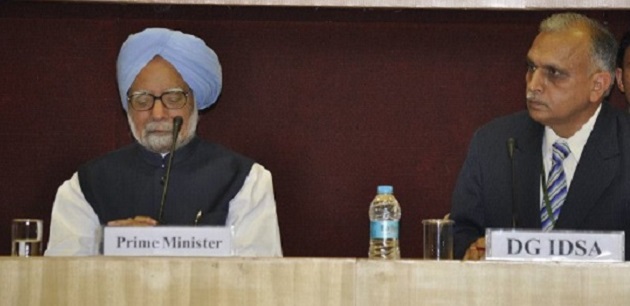Can a Nuclear Armed State Champion the Cause of Nuclear Disarmament?

The strategic rationale for nuclear weapons has disappeared since the end of the Cold War. The establishment of a global ‘no first-use’ norm would lay the groundwork for further reductions in nuclear arsenals.
Forty-four years after the NPT came into force, the world still finds itself perilously close to the edge of the nuclear cliff. The cliff is perhaps not quite as steep as it was in the 1980s, when there were more than 70,000 nuclear weapons compared to today’s 17,000, but going over it would still be fatal for planet Earth. A perverse mixture of hubris and arrogance on the part of the nine nuclear-armed states (China, France, India, Israel, North Korea, Pakistan, Russia, UK, and USA) exposes us to the risk of sleepwalking into a nuclear disaster.
The Danger
For nuclear peace to hold, deterrence and fail-safe mechanisms must work every single time. For nuclear Armageddon, deterrence or fail safe mechanisms need to break down only once. This is not a comforting equation. Deterrence stability depends on rational decision-makers being always in office on all sides: a dubious and not very reassuring precondition. It depends equally critically on there being no rogue launch, human error or system malfunction: an impossibly high bar. According to one US study, more than 1,200 nuclear weapons were involved in significant incidents from 1950-68 because of security breaches, lost weapons, failed safety mechanisms, or accidents resulting from weapons being dropped or crushed in lifts.
Nuclear weapons were invented to cope with Germany, used to defeat Japan, and deployed most extensively against the Soviet Union. Their primary strategic rationale disappeared with the end of the Cold War. The very fact that nuclear weapons have not been used again since 1945 is powerful evidence that their sheer destructiveness makes them virtually unusable.
While the dramatic fall in their numbers since the 1980s has occurred through bilateral agreements and measures between Moscow and Washington, their irreversible elimination will have to rest on a legally binding international convention. The prospects for such a treaty would be significantly greater if it were to be championed by a credible country from among the nine nuclear powers.
India’s Role
India should step forward to be a champion of phased, regulated and verifiable global nuclear disarmament governed by a universal, non-discriminatory nuclear weapons convention. This would be in keeping with the legacy of numerous Indian initiatives on nuclear arms control and disarmament; with the fact that India was the most reluctant nuclear weapons possessor of all the nine nuclear-armed states; and the somewhat incongruent reality that its official nuclear doctrine lists global nuclear disarmament as a national security objective.
Inaugurating a conference on April 2, Prime Minister Manmohan Singh reaffirmed that “As a responsible” nuclear armed state, “India supports the idea of a nuclear-weapon-free world because we believe that it enhances not just India’s security, but also global security.” He insisted that “there is no paradox in a nuclear weapon state like India being a strong advocate of a nuclear-weapon-free world.”
On March 9, senior BJP leader and former Foreign Minister Yashwant Sinha wrote to PM Singh demanding his address to the conference be cancelled and the conference itself be postponed to after the elections. Sinha added that the agenda showed the speakers to be mainly “known anti-India… nonproliferationists” who have “been bashing India.”
He should sack the aide who gave him this information. There were indeed some speakers who are strong advocates of non-proliferation and were never reconciled to India’s nuclear weaponisation. No seminar on the challenge of nuclear weapons can be balanced and credible if it excludes this viewpoint. But most speakers were passionate nuclear abolitionists, directing their arguments at all who possess and seek security through nuclear weapons that intensify the whole world’s insecurity dilemmas and dangers. Indeed the title of the seminar, organized and hosted by Institute for Defence Studies and Analyses (IDSA) on April 2–3, was “A Nuclear-Weapon-Free World: From Conception to Reality.”
PM Singh ignored the letter as part of the silly season of campaign politics. In his address Singh called for practical measures to “reduce nuclear dangers by reducing the salience of nuclear weapons in security doctrines.” Importantly, he called on all nuclear-armed states to establish a global no-first-use norm. India thus joins China in this demand and the two Asian giants could team up to turn this aspiration into a concrete proposal and program of action. The BJP subsequently hinted that if it forms government next month, it might reverse the no first use policy. But it quickly back-pedalled in response to the resulting national and international furore.
The Benefits
It is simplistic to dismiss “no first use” as merely declaratory, easily ignored in war time. A universal no-first-use policy by all nine nuclear-armed states would have considerable practical import with flow-on requirements for nuclear force posture and deployment, for example, de-alerting (taking warheads off hair-trigger alert), de-mating (separating warheads from delivery systems), and de-targeting. China is already a good exemplar on this point.
In turn this would reduce trust deficits and promote confidence building while strengthening the norm of non-use of nuclear weapons. The norm would then lay the groundwork for further gradual reductions in the number of nuclear warheads held by the various nuclear armed states and their eventual elimination through a nuclear weapons convention.
Professor Ramesh Thakur is Director, Centre for Nuclear Non-Proliferation and Disarmament, The Australian National University.
This article was previously published in The Japan Times.





